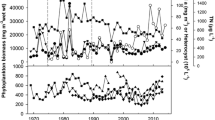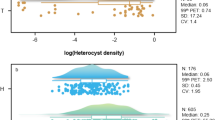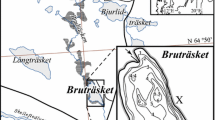Abstract
The fixation of molecular nitrogen (N2fix) by cyanobacteria in situ and in PO4-P enrichment experiments was investigated in large shallow Lake Võrtsjärv in 1998–2000. In this lake, N2fix started when TN/TP mass ratio was about 20, which is much higher than Redfield mass ratio 7. The rate of N2fix varied between 0.81 and 2.61 μgN l−1 d−1 and maximum rate (2.61 μgN l−1 d−1) was measured in 15.08.2000. In L. Võrtsjärv a lag period of a couple of weaks occurred between the set-up of favourable conditions for N2fix as the appearance of N2-fixing species and depletion of mineral nitrogen, and the real N2fix itself. However, if the favorable conditions for N2fix occurred in the lake, N2fix started after enrichment with PO4-P in mesocosms even then when no N2fix was detected in the lake. N2fix in mesocosms was also more intensive than in lake water. In our experiments PO4-P concentrations higher than 100 μgP l−1started to inhibit N2fix.
Similar content being viewed by others
References
Brock, T. D., M. T., Madigan, J. M. Martinko & J. Parker, 1994. Biology of Microorganisms. Prentice-Hall International Inc.: 617–621; 656–658; 734–735.
Bulgakov, N.G. & A. P. Levich, 1999. The nitrogen: phosphorus ratio as a factor regulating phytoplankton community structure. Arch. Hydrobiol. 146: 3–22.
Cole, G. A., 1983. Textbook of Limnology. 3rd edn. The C. V. Mosby Company: 324–327.
Flett, R. J., D. W. Schindler, R. D. Hamilton & N. E. R. Campbell, 1980. Nitrogen fixation in Canadian Precambrian Shield lakes. Can. J. Fish. aquat. Sci. 37: 494–505.
Flett, R. J., R. D. Hamilton, & N. E. R. Campbell, 1976. Aquatic acetylene-reduction techniques: solutions to several problems. Can. J. Microbiol. 22(1): 43–51.
Golterman, H. L., 1975. Physiological Limnology. Elsevier Scientific Publishing Company: 99–108.
Granhall, U. & A. Lundgren, 1971. Nitrogen fixation in lake Erken. Limnol. Oceanogr. 16. 5: 711–719.
Grasshoff, K., M. Ehrhardt & K. Kremling, 1983. Methods of Seawater Analysis. Verlag Chemie, Weinheim: 419 pp.
Haberman, J., P. Nõges, E. Pihu, T. Nõges, K. Kangur, & V. Kisand, 1998. Characterization of L. Võrtsjärv.–Limnologica 28(1): 3–11.
Hambright, K. D., T. Zohary, J. Easton, B. Azoulay, & T. Fishbein, 2001. Effects of zooplankton grazing and nutrients on the bloom-forming, N2-fixing cyanobacterium Aphanizomenon in Lake Kinneret. J. Plankton Res., 23: 165–174.
Harris, G. P., 1986. Phytoplankton Ecology. Chapman and Hall, U.S.A.: 137–165.
Helal, H. A. & D. A. Culver, 1991. N: Pratio and plankton production in fish hatchery ponds. Verh. int. Ver. Limnol. 24: 1508–1511.
Horne, A. J., J. E. Dillard, D. K. Fujita & C. R. Goldman, 1972. Nitrogen fixation in Clear Lake, California. II. Synoptic studies on the autumn Anabaena bloom. Limnol. Oceanogr. 17(5): 693–703.
Horne, A. J., J. C. Sandusky & C. J. W. Carmiggelt, 1979. Nitrogen fixation in Clear Lake, California. 3III. Repetitive synoptic sampling of the spring Aphanizomenon blooms. Limnol. Oceanogr. 24(2): 316–328.
Howarth, R. W., J. J. Cole, R. Marino & J. Lane, 1988a. Nitrogen fixation in freshwater, estuarine and marine ecosystems. 1. Rates and importance. Limnol. Oceanogr. 33(4): 669–687.
Howarht, R.W., J. J. Cole, & R. Marino, 1988b. Nitrogen fixation in freshwater, estuarine and marine ecosystems. 2. Biogeochemical controls. Limnol. Oceanogr. 33(4): 688–701.
Howarth, R. W. & J. J. Cole, 1985. Molybdenum availability, nitrogen limitation, and phytoplankton growth in natural waters. Science 229: 653–655.
Howarth, R. W. & R. Marino, 1990. Nitrogen-fixing cyanobacteria in the plankton of lakes and estuaries: a reply to the comment by Smith. Limnol. Oceanogr. 35(8): 1859–1863.
Hudson, J. J., W. D. Taylor, & D. W. Schindler, 2000. Phosphate concentrations in lakes. Nature. 406: 54–56.
Huttula, T. & T. Nõges (eds.), 1998. Present State and Future Fate of Lake Võrtsjärv. Tampere: 150 pp.
Karl, D. M., 2000. Phosphorus, the staff of life. Nature 406: 31–32.
Kostyaev, V. J., 1986. Biologiya i Èkologiya Azotfiksiruyushchih Sinezelenyh Vodoroslej Presnyh Vod [Biology and Ecology of Nitrogen Fixing Cyanobacteria from Inland Water]. Leningrad 122 pp.
Leppänen,. J. M., A. Niemi & I. Rinne, 1988. Nitrogen fixation of cyanobacteria (blue-green algae) and the nitrogen cycle of the Baltic sea. Symbiosis 6: 181–194.
Levine, S. N. & D. W. Schindler, 1992. Modification of the N: P ratio in lakes by in situ processes. Limnol. Oceanogr. 37: 917–935.
Levine, S. N. & D. W. Schindler, 1999. Influence of nitrogen to phosphorus supply ratios and physicochemical conditions on cyanobacteria and phytoplankton species composition in the Experimental Lakes Area, Canada. Can. J. Fish. aquat. Sci. 56: 451–466.
MacKay, N. A. & J. J. Elser, 1998. Nutrient recycling by Daphnia reduces N2 fixation by cyanobacteria. Limnol. Oceanogr. 43(2): 347–354.
Michard, M., L. Aleya, & J. Verneaux, 1996. Mass occurrence of the Cyanobacteria Microcystis aeruginosa in the hypereutrophic Villerest Reservoir (Roanne, France): usefulness of the biyearly examination of N/P (nitrogen phosphorus) and P/C (protein/ carbohydrate) couplings. Arch. Hydrobiol. 135: 337–359.
Niemi, A., 1979. Blue-green algal blooms and N:P ratio in the Baltic Sea. Acta Bot. Fenn. 110: 57–61.
Nixdorf, B. & R. Deneke, 1997. Why ‘very shallow’ lakes are more successful opposing reduced nutrient loads. Hydrobiologia 342/343: 269–284.
Nõges, P. & T. Feldmann, 1999. Factors controlling the distribution of aquatic macrophytes in shallow Lake Võrtsjärv. In: Sustainable Lake Management. 8th Int. Conf. Conserv. Manag. Lakes 4 pp.
Nõges, T. & P. Nõges, 1999. The effect of extreme water level decrease on hydrochemistry and phytoplankton in a shallow eutrophic lake. Hydrobiologia 408/409: 277–283.
Présing, M., S. Herodek, L. Vörös & I. Kobor, 1996. Nitrogen fixation, ammonium and nitrate uptake during a bloom of Cylindrospermopsis raciborskii in Lake Balaton. Arch. Hydrobiol. 136: 553–562.
Présing, M., K. V.-Balogh, L. Vörös & H. M. Shafik, 1997. Relative nitrogen deficiency without occurrence of nitrogen fixing bluegreen algae in a hypertrophic reservoir. Hydrobiologia 342/343: 55–61.
Schindler, D.W., 1977. Evolution of phosphorus limitation in lakes. Science 195: 260–262.
Seip, K. L., 1994. Phosphorus and nitrogen limitation of algal biomass across trophic gradients. Aquat. Sci. 56: 16–28.
Smith, Val H., 1985. Predictive models for the biomass of bluegreen algae in lakes. Wat. Resour. Bull. 21(3): 433–439.
Smith, Val H., 1983. Low nitrogen to phosphorus ratios favor dominance by blue-green algae in lake phytoplankton. Science. 221: 669–670.
Smith, Val H., 1990. Effects of nutrients and non-algal turbidity on blue-green algal biomass in four North Carolina reservoirs. Lake and Reservoir Management 6: 125–131.
Smith, Val H. & S. J. Bennett, 1999. Nitrogen: phosphorus supply ratios and phytoplankton community structure in lakes. Arch. Hydrobiol. 146: 37–53.
Smith, Val H., V. J. Bierman, L. J. Bradley & K. Havens, 1995. Historical trends in the Lake Okeechobee ecosystem IV. Nitrogen: phosphorus ratios, cyanobacterial dominance, and nitrogen fixation potential. Arch. Hydrobiol./Suppl. Monogr. Beitr. 107: 71–88.
Stewart, W. D. P., G. P. Fitzgerald & R. M. Burris, 1967. In situ studies on N2 fixation using the acetylene reduction technique. Proc. natn. Acad. Sci. U.S.A. 58: 2071–2078.
Tilman, D., S. S. Kilham & P. Kilham, 1982. Phytoplankton community ecology: the role of limiting nutrients. Ann. Rev. Ecol. Syst. 13: 349–372.
Toetz, D. & M. McFarland, 1987. Lake loading ratios (N: P) and lacustrine nitrogen fixation. Water Resour. Bull. 23: 239–241.
Utermöhl, H., 1958. Zur Vervollkommnung der quantitativen Phytoplankton Methodik. Mitt. int. Ver. Theor. Angew. Limnol. 9: 1–38.
Author information
Authors and Affiliations
Rights and permissions
About this article
Cite this article
Tõnno, I., Nõges, T. Nitrogen fixation in a large shallow lake: rates and initiation conditions. Hydrobiologia 490, 23–30 (2003). https://doi.org/10.1023/A:1023452828667
Issue Date:
DOI: https://doi.org/10.1023/A:1023452828667




